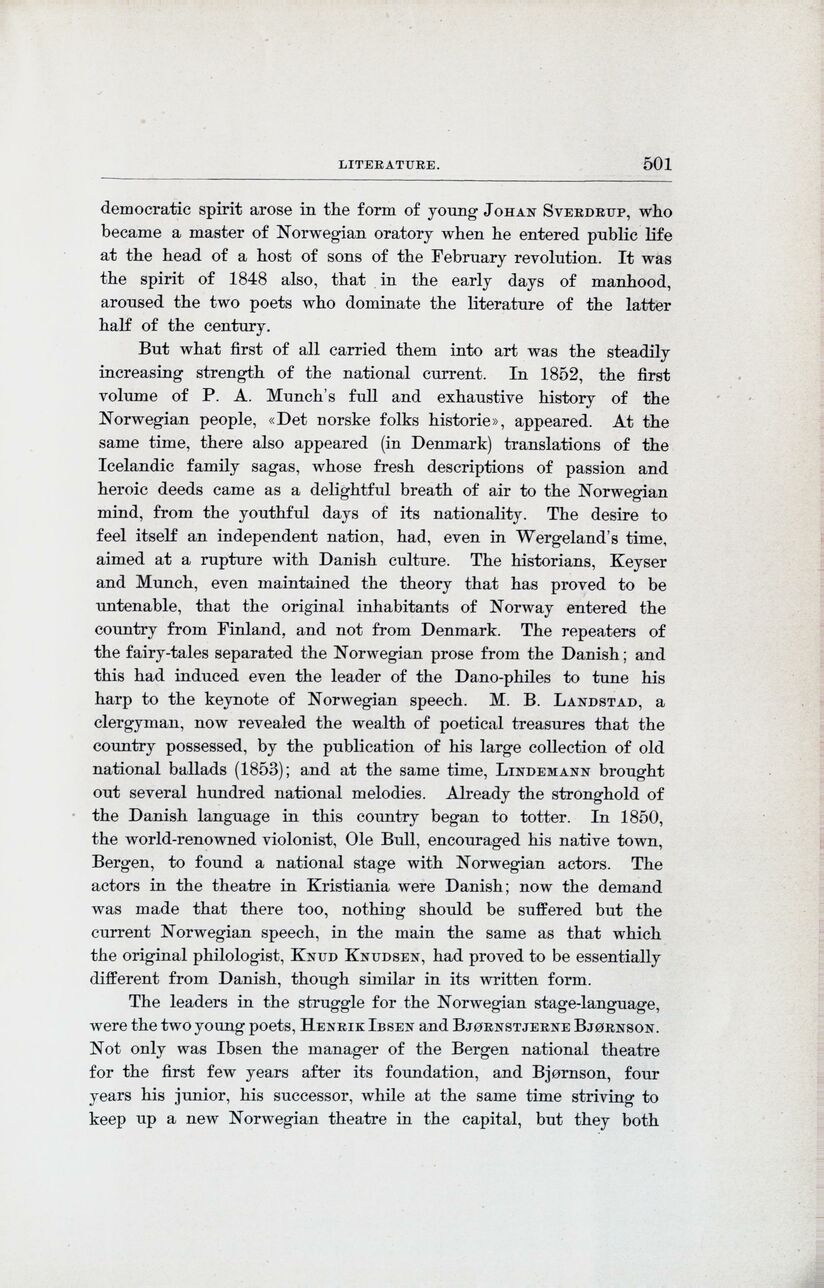
Full resolution (JPEG) - On this page / på denna sida - Literature, by Chr. Brinchmann

<< prev. page << föreg. sida << >> nästa sida >> next page >>
Below is the raw OCR text
from the above scanned image.
Do you see an error? Proofread the page now!
Här nedan syns maskintolkade texten från faksimilbilden ovan.
Ser du något fel? Korrekturläs sidan nu!
This page has been proofread at least once.
(diff)
(history)
Denna sida har korrekturlästs minst en gång.
(skillnad)
(historik)
democratic spirit arose in the form of young Johan Sverdrup, who
became a master of Norwegian oratory when he entered public life
at the head of a host of sons of the February revolution. It was
the spirit of 1848 also, that in the early days of manhood,
aroused the two poets who dominate the literature of the latter
half of the century.
But what first of all carried them into art was the steadily
increasing strength of the national current. In 1852, the first
volume of P. A. Munch’s full and exhaustive history of the
Norwegian people, «Det norske folks historie», appeared. At the
same time, there also appeared (in Denmark) translations of the
Icelandic family sagas, whose fresh descriptions of passion and
heroic deeds came as a delightful breath of air to the Norwegian
mind, from the youthful days of its nationality. The desire to
feel itself an independent nation, had, even in Wergeland’s time,
aimed at a rupture with Danish culture. The historians, Keyser
and Munch, even maintained the theory that has proved to be
untenable, that the original inhabitants of Norway entered the
country from Finland, and not from Denmark. The repeaters of
the fairy-tales separated the Norwegian prose from the Danish; and
this had induced even the leader of the Dano-philes [[** sic]] to tune his
harp to the keynote of Norwegian speech. M. B. Landstad, a
clergyman, now revealed the wealth of poetical treasures that the
country possessed, by the publication of his large collection of old
national ballads (1853); and at the same time, Lindemann brought
out several hundred national melodies. Already the stronghold of
the Danish language in this country began to totter. In 1850,
the world-renowned violonist, Ole Bull, encouraged his native town,
Bergen, to found a national stage with Norwegian actors. The
actors in the theatre in Kristiania were Danish; now the demand
was made that there too, nothing should be suffered but the
current Norwegian speech, in the main the same as that which
the original philologist, Knud Knudsen, had proved to be essentially
different from Danish, though similar in its written form.
The leaders in the struggle for the Norwegian stage-language,
were the two young poets, Henrik Ibsen and Bjørnstjerne Bjørnson.
Not only was Ibsen the manager of the Bergen national theatre
for the first few years after its foundation, and Bjørnson, four
years his junior, his successor, while at the same time striving to
keep up a new Norwegian theatre in the capital, but they both
<< prev. page << föreg. sida << >> nästa sida >> next page >>